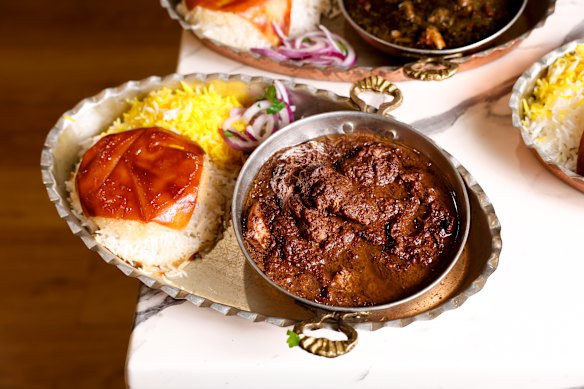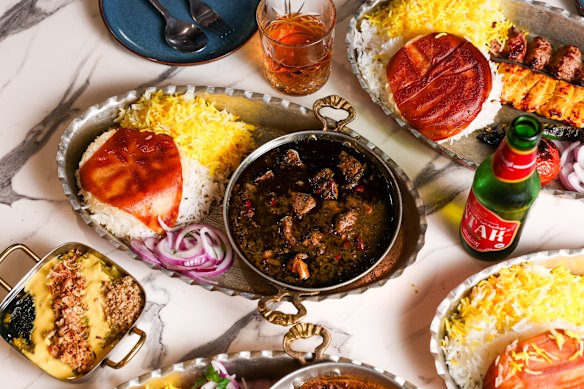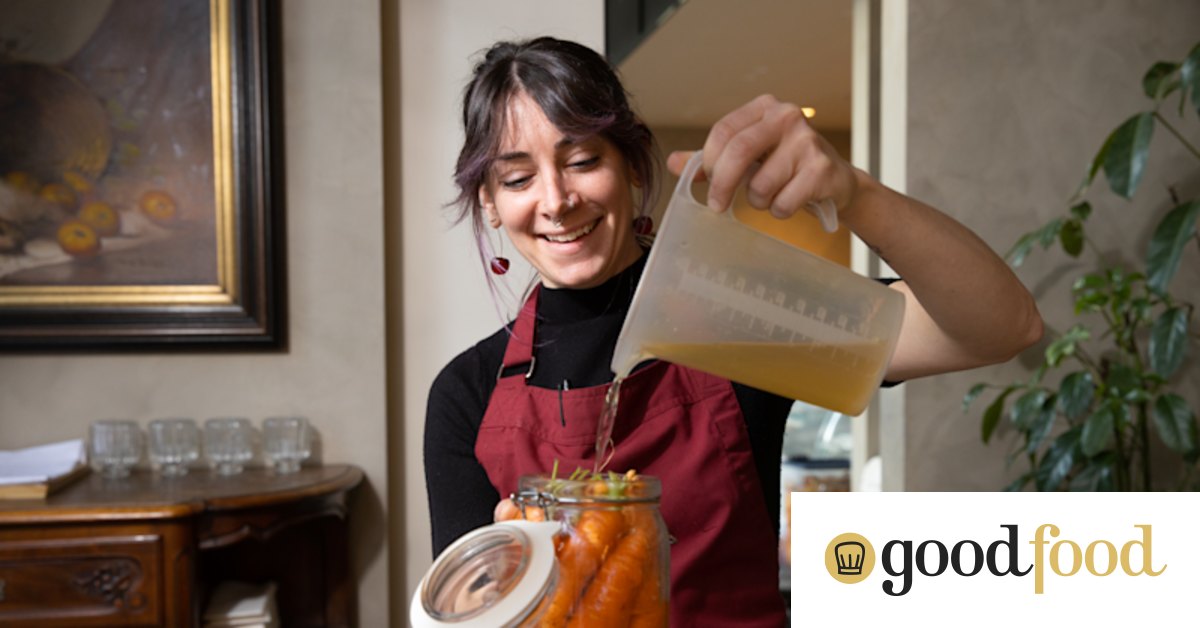Marinated minced lamb and chicken skewers are the most popular dishes at Carlingford restaurant Surena, grilled on sword-like sticks and fanned furiously over charcoal.
You have reached your maximum number of saved items.
Remove items from your saved list to add more.
Save this article for later
Add articles to your saved list and come back to them anytime.
13.5/20
Persian$$$$
Cantonese people call it fan jiew, Koreans know it as nurungji, and Spaniards describe it as soccarat. It’s the layer of scorched rice you find at the bottom of the pot – or paella pan – that unleashes so much heart-clutching joy around the world. For Persians, this brittle crackly rice is called tahdig, which translates to “bottom of the pot” in Farsi.
Tahdig is on every table at Surena, bustling with families and gatherings of friends. The version here is lined with a layer of lavash bread before adding the rice and oil. The result? A golden cap of shattering crunch that makes a terrific contrast to pillow-soft basmati grains.

There are 150 tahdig pots in the kitchen, says Mehdi Mousavi, restaurant co-owner with wife Fatemeh Mahmoudi. The pots were brought back from Iran, and up to 15 of them are in the oven at any one time, blasted at 400 degrees for five minutes to create the rice’s trademark bottom.
Surena is a busy restaurant. The sea of midnight blue velvet chairs and decorative table numbers may also make you feel like you’ve stumbled into a Persian wedding reception. (Iranian pop music videos add to the charm.) First opening in Hornsby in 2020, the restaurant moved to its current location in Carlingford in late 2022.
Koubideh marinated minced lamb and joojeh marinated chicken skewers are the most popular dishes, grilled on sword-like skewers and fanned furiously over charcoal. The meats are complemented with grilled tomato and green chilli, a hunk of raw onion and the biggest mountain of saffron rice – capped with crunchy tahdig – you may have ever set eyes on. The metal plates are huge, looking more like serving dishes.

We gravitate towards the torsh kebab, described as sour on the menu but in reality leaning more to tangy and sweet. The marinade of pomegranate molasses, walnuts and herbs is flavour-packed and makes for a juicy lamb fillet that hums sweetness and zing.
The pomegranate molasses and crushed walnut combination is also used to marinate green olives called zeytoon parvadeh. Add garlic and fresh mint, and we can’t get enough of this starter that’s equal parts sharp, salty and sweet.
Fesenjan, one of Persia’s most iconic dishes, is also big on pomegranate and walnut. Tender hunks of chicken are enrobed in a sauce spiced with turmeric, slightly sour from pomegranate but tempered by the creaminess of ground walnuts. There’s a little sweetness, too, that makes fesenjan intriguingly addictive.

Like tangy, savoury-sour things? Then you’ll love ghormeh sabzi. Arguably considered Iran’s national dish, the aromatic stew of diced grass-fed lamb and kidney beans is a deep olive-green from leek, parsley, coriander and spinach. A signature piquancy comes from limoo amani dried limes. First brined then sun-dried, these rehydrated limes add layers of tart, citrusy and bitter notes.
Smoky grilled eggplant pops up in numerous places. Kashk o bademjan is a chunky eggplant dip fortified with a patterned arrangement of caramelised onion, crushed walnuts, fried mint and kashk, a traditional whey that adds an almost blue-cheesy profile. For more dipping action, the borani features eggplant mixed through yoghurt and what tastes like a whole bulb of garlic. Fried lavash crackers on the side make for compulsive nibbling.
Meanwhile, ash reshteh is a big hug in a bowl for winter, and super filling with its melange of red beans, white beans, chickpeas and lentils. Fresh parsley, coriander and spinach add freshness while the reshteh flat noodles thicken the soup with their starchiness. Skip the kashk if you want to make it vegan.
Pick of the desserts is the faloodeh and ice-cream, a refreshing jumble of vermicelli-style noodles in rosewater granita with pistachio slivers and sour cherry jam. I make a note to return in summer, when its combination of pistachio and saffron ice-creams probably tastes twice as good. First, though, our group needs to make it through the three boxes of leftover rice and tahdig we pack up to take home.
The low-down
Atmosphere: Persian wedding reception guest vibes complete with Iranian pop music video clips
Go-to dishes: Torsh sour kebab ($33); ghormeh sabzi ($24); and fesenjan ($26).
Drinks: Giant jugs of doogh drinking yoghurt and non-alcoholic malt in flavours including pomegranate, apple and peach. BYO is available
Cost: $70 for two, excluding drinks
Good Food reviews are booked anonymously and paid independently. A restaurant can’t pay for a review or inclusion in the Good Food Guide.
Restaurant reviews, news and the hottest openings served to your inbox.
You have reached your maximum number of saved items.
Remove items from your saved list to add more.






